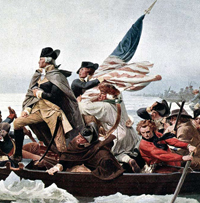1852
Uncle Tom’s Cabin, by Harriet Beacher Stowe
National Era, an abolitionist weekly, paid Harriet Beecher Stowe $300 for the serial rights to her novel that profoundly affected Americans’ attitudes toward slavery. Because of the story’s popularity, J. P. Jewett and Co. convinced Stowe to publish her serial as a book, which immediately became a must-read for concerned citizens.
In 1862, when President Abraham Lincoln met Stowe, he is purported to have said, “so you’re the little lady who wrote the book that started this great war.” Though scholars dispute whether this conversation ever took place, the role of “Uncle Tom’s Cabin” in turning public sentiment against slavery is undeniable, Winship says.
Today, the novel continues to spark discussion about race due to its stereotypical depictions of African-Americans that inspired a melodramatic theatrical tradition.
“After becoming an American classic, it came to be viewed as an embarrassment,” Winship says. “Only recently have scholars begun the task of reassessing its place in American literary culture. It remains to be seen just how it will be evaluated as we continue to struggle with our vexed history of race relations in the United states.”
1906
The Jungle, by Upton Sinclair
Muckraking journalist Upton Sinclair wrote the ferocious exposé, “The Jungle,” to raise awareness of the plight of immigrant factory workers in Chicago’s meat-packing industry. Instead, the American public was horrified at the thought of finding a finger in their sausage, says Brian Stross, professor of anthropology who researches American food cultures.
Within six months of the book’s publication, President Theodore Roosevelt began an inquiry and Congress passed the Meat Inspection Act and the Pure Food and Drug Act, laying the foundation for the establishment of the Food and Drug Administration.
“Long before Eric Schlosser’s ‘Fast Food Nation’ sent diners scurrying from their local McDonald’s, Sinclair was turning American stomachs and feeding a furor for reform in meat-packing plants that soon spread to other food industries,” says Michael Stoff, director of Plan II Honors and associate professor of history.
Sinclair’s book was meant to expose the horrid conditions in which immigrants worked. Instead it struck a different target. “I aimed for the public’s heart,” Sinclair later complained, “and by accident hit it in the stomach.”
1962
Silent Spring, by Rachel Carson
After working for the U.S. Fish and Wildlife Service for 17 years and learning about the abuse of pesticides, Rachel Carson wrote the environmental treatise, “Silent Spring.” She challenged the widespread use of chemical fertilizers and environmentally harmful strategies of industrial agriculture following World War II.
Originally serialized in The New Yorker in June 1962, “Silent Spring” was published three months later in book form by Houghton Mifflin. The book sparked widespread concern about pollution, which led Congress to pass the Pesticide Control Act of 1972.
“‘Silent Spring’ is a testament to how conventional environmental practices and policy can change dramatically when just one person has the courage to challenge the status quo,” says Brian King, assistant professor of geography and the environment who teaches courses on conservation.
In an introduction to the 1994 edition of the book, former Vice President Al Gore called the book a “cry in the wilderness.” Without it, the environmental movement might have been long delayed or never developed at all, he asserts. “The human race is challenged more than ever before to demonstrate our mastery—not over nature, but of ourselves,” Carson wrote, inspiring a generation of activists.
1963
The Feminine Mystique, by Betty Friedan
“A woman has got to be able to say, and not feel guilty, ‘Who am I, and what do I want out of life?’ she mustn’t feel selfish and neurotic if she wants goals of her own, outside of husband and children,” wrote Betty Friedan in “The Feminine Mystique,” a book credited with starting the contemporary women’s movement.
“The Feminine Mystique” contributed to big advances in women’s legal rights, such as equal economic opportunity for women, espoused in Title VII of the Civil Rights Act of 1964, and equal educational opportunity for women, included in Title IX of the Education amendments of 1972, says Gretchen Ritter, professor of government.
“Friedan eloquently articulated the sense of uneaseand disaffection that many women felt with the limitations imposed on them in post-war America,” Ritter explains. “Today, her work continues to inspire the next generation of women to reconsider the meaning of womanhood in American society and explore the impact that balancing work and family has on gender equality.”
Read the full feature story of “Books that Changed America,” which includes Winship’s optimistic prediction about the power of the book despite declining book readership nationally.
